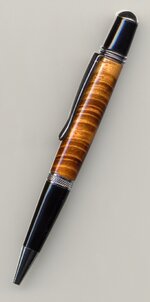Tiger
Member
I use a skew chisel mainly on pens that have straight grained timber or on acrylics and use them it in its conventional manner ie with planing cuts. I notice that some turners lay it flat on the tool rest and use it in a scraping mode, I've had less success there. It is useful in this mode because it helps to smooth things out but sometimes it causes chipout or the heel/toe scratches the blank unintentionally. I thought that I would grind the skew with a slight curve so as to avoid the unintentional skew contact but results are not a lot better. So how do those turners who use the skew exclusively on pens grind their skews and also do you use the skew on cross-grain and sensitive timbers like burls? I keep my skew sharp and try to take light cuts.

